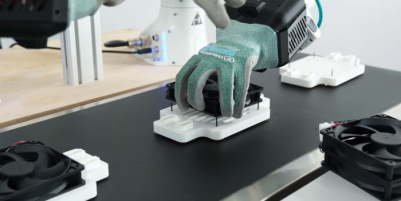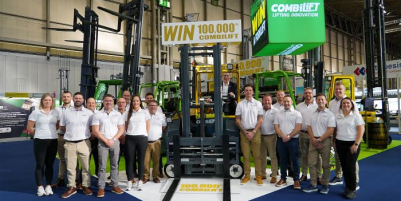-
AI startup Onton raises $7.5M to reinvent the way the world discovers and decides what to buy - November 26, 2025
-
Forklift Market Positions for Recovery as Confidence Expected to Build from 2026 - November 26, 2025
-
PROCare achieves 300% order capacity increase and 99% picking accuracy with Forterro’s ERP solution, Orderwise - November 26, 2025
-
DHL boosts operational efficiency and customer communications with HappyRobot’s AI Agents - November 25, 2025
-
STENA LINE TEAMS UP WITH CAMERA TELEMATICS TO DRIVE SAFETY IMPROVEMENTS AT IRISH SEA PORTS - November 25, 2025
-
Another design award for Toyota’s lithium-ion Traigo_i counterbalanced forklift - November 21, 2025
-
Stuut Technologies Raises $29.5 Million Series A Led by Andreessen Horowitz to Automate Accounts Receivable Work - November 20, 2025
-
INCREASED DIGITAL INVESTMENT REQUIRED TO KEEP PACE WITH 2026 CUSTOMS CHANGES - November 19, 2025
-
FULFILMENT SOLUTIONS FOR SPORTS MERCHANDISE: KEEPING OUR EYE ON THE GAME - November 19, 2025
-
COMPLEX, COSTLY & CONFUSING – THE END OF DE MINIMIS - November 19, 2025
Ever more logistics companies are seeking ways of maintaining or improving operational efficiency and customer service levels with fewer people, says Xia Hulling, founder and CEO of robotic sortation system specialist LiBiao Robotics
Alongside the construction and hospitality industries, logistics is among the business sectors to have been hit hardest by Europe’s dwindling labour market and the resultant recruitment issues.
The global pandemic and the economic and social turbulence that came with it is at least partly responsible for the pan-European workforce crisis, but, while every country saw lockdown blow a hole in the size of its workforce, other factors, such as an ageing population (more workers are reaching retirement age than are entering the jobs market) and record low levels of unemployment, are also contributing to the unprecedented labour shortages that Europe’s logistics operators now face.
And it seems that human resources – or, rather, a lack of human resources – are likely to be a long term problem across the continent. In France for example, The Center for Global Development projects that a worker gap of 3.9 million will have opened by 2050, while economists forecast that Germany’s workforce will peak in 2023 and then shrink by up to five million people by the end of the decade.
Many European countries are reporting record numbers of unfilled vacancies. Belgium, the Netherlands and Austria have all broken their respective ‘SITS VAC’ records recently while the United Kingdom currently has in excess of one million unfilled positions for the first time ever.
Reduced staff numbers can put significant strain on the existing employees within the warehouse and make an already physically demanding job more difficult and, therefore, even less appealing to potential new recruits. So, in effect, the labour crisis is making it harder to fix the labour crisis!
HGV drivers, warehouse order pickers and forklift operators are all proving difficult to attract and retain which means warehouse operators have had to increase wages and other employee perks to attract skilled personnel in the quantity that they are needed. However, given that wages are already one of the most significant costs associated with running a warehouse, the handsome financial packages that are now required to tempt forklift operators or other warehouse staff are prompting more and more logistics companies to seek new ways of maintaining or improving their levels of operational efficiency and customer service with fewer people.
It is no surprise then that those logistics companies who feel that a lack of staff is holding them back now – or Is likely to limit their growth potential in the future – are choosing to automate aspects of their intralogistics process.
Parcel sorting is one of the warehouse activities that is being automated increasingly frequently. Sortation systems based on Autonomous Mobile Robot (AMR) technology greatly reduce demands on manual workers in the sorting process, improve efficiency and greatly improve accuracy rates. And, for operations with a short delivery cycle and a high volume, such as ecommerce fulfilment centres, sorting robot systems represent a particularly attractive proposition.
One of the early pioneers of AMR-based sortation technology was LiBiao Robotics. LiBiao’s ‘Mini Yellow’ range of mobile sorting robots was developed as an extremely cost-efficient and flexible alternative to fixed tilt-tray and cross-belt conveyor-based sortation systems that were traditionally used within many busy parcel and e-commerce operations.
‘Mini Yellow’ robots (which are supported by a network of authorised dealers throughout Europe) are quick and easy to install and require minimal maintenance. The modular system is scalable and offers complete flexibility as additional robots are introduced as and when they are needed.
A recent adopter of ‘Mini Yellow’ robot technology – Hellenic Post (ELTA), the state-owned provider of postal services in Greece. – has been able to reduce its labour costs significantly and, because LiBiao robots are highly energy efficient, minimize on-site power consumption since its AMR sorting system went live.
With the shrinking labour pool making it harder to find and retain the people needed to undertake tasks traditionally performed by low-skilled workers in warehouses across Europe, there is likely to be no let up in the number of companies opting to take a robotic approach to sortation.

































